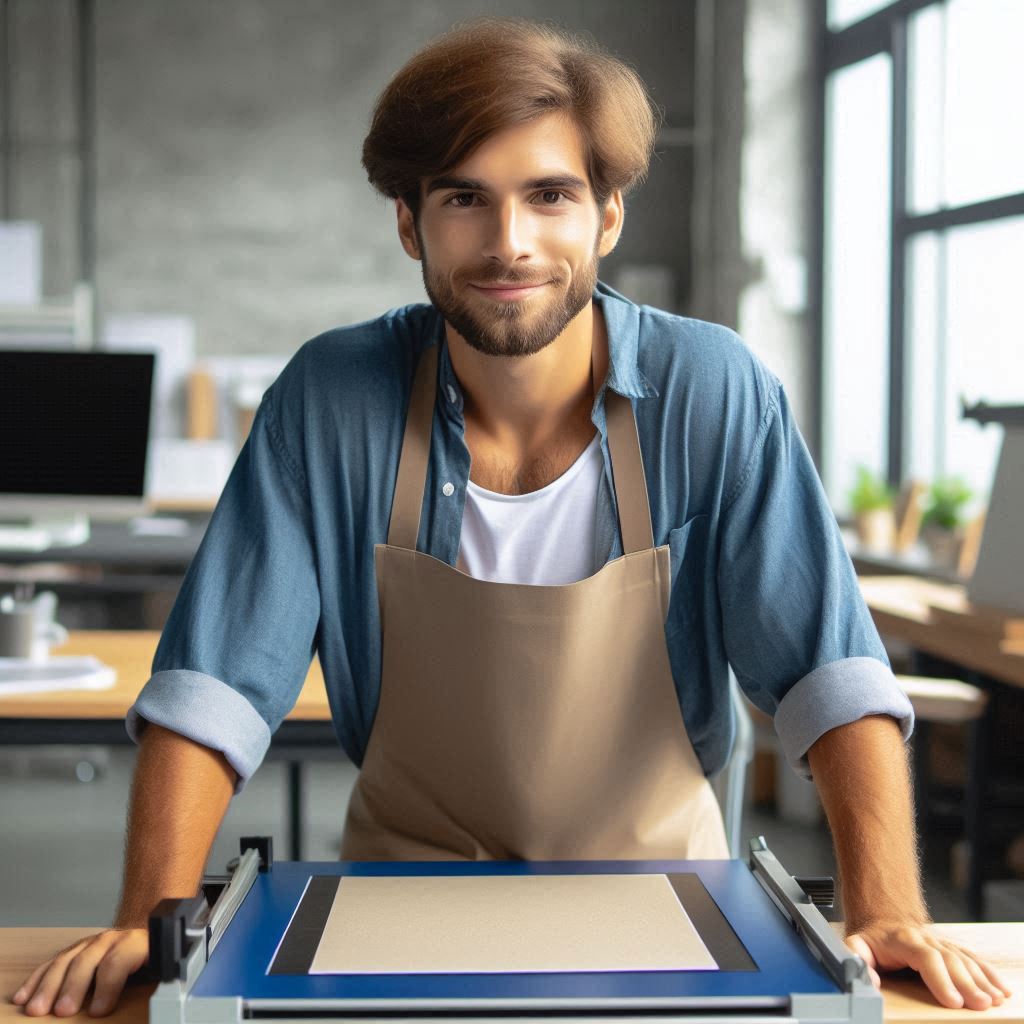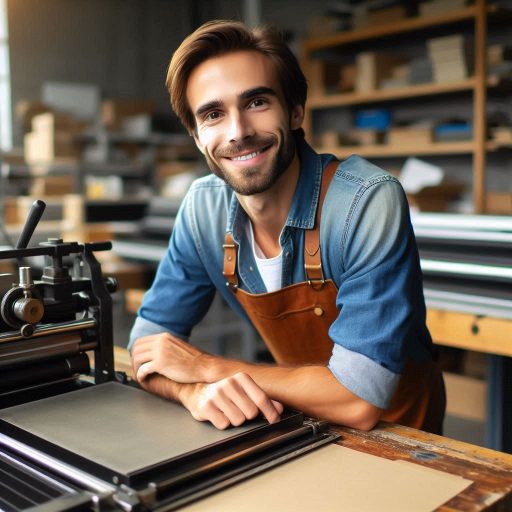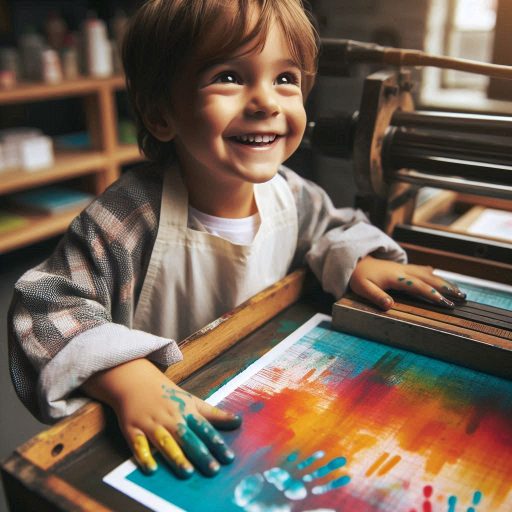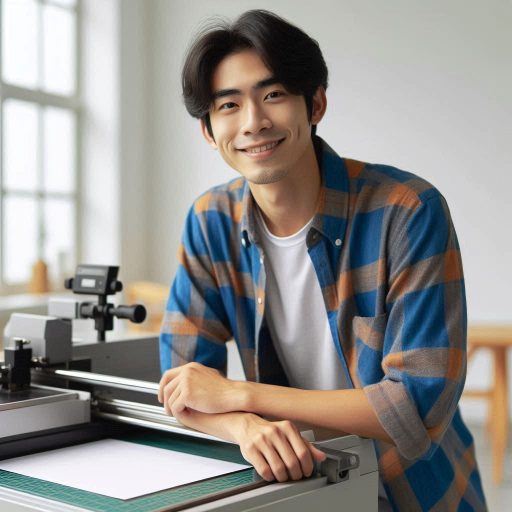Introduction
Printmaking is a dynamic art form with roots stretching back centuries.
Artists use various techniques like etching, lithography, and screen printing to create unique, reproducible works.
Over time, these methods have evolved, blending traditional practices with innovative approaches.
Today, modern printmaking encompasses a broad range of styles and technologies, including digital processes and experimental materials.
Staying updated on current trends in printmaking is crucial for artists and collectors alike.
The art world constantly shifts, and those who embrace new techniques often find greater success.
By understanding these trends, printmakers can push the boundaries of their work, ensuring their art remains relevant.
Additionally, collectors gain a deeper appreciation of the art form, recognizing the value of contemporary works.
Technological advances play a major role in shaping modern printmaking.
Digital tools like laser cutters and 3D printers open new possibilities for artistic expression.
Alongside these innovations, printmakers continue to explore sustainable practices, such as using eco-friendly materials and processes.
This shift reflects a growing awareness of environmental concerns within the art community.
In essence, printmaking’s rich history is matched by its ever-evolving future.
Artists who embrace modern trends keep their craft alive and engaging.
Evolution of Printmaking Techniques
Printmaking has a rich history that has evolved over time, from traditional methods to modern techniques.
Traditional printmaking techniques such as woodcut, engraving, etching, and lithography have been practiced for centuries.
These techniques involve carving or etching an image onto a surface, inking it, and then transferring the image onto paper or another material.
Traditional vs. modern techniques
Traditional printmaking techniques require a high level of skill and craftsmanship.
Artists need to have a deep understanding of the materials and tools used in the process.
Modern techniques, on the other hand, often involve the use of digital technologies such as computers and printers.
Transform Your Career Today
Unlock a personalized career strategy that drives real results. Get tailored advice and a roadmap designed just for you.
Start NowDigital printing allows artists to create intricate designs and vibrant colors with ease.
Impact of technology on printmaking processes
Technology has revolutionized the field of printmaking, making the process faster, more efficient, and more accessible to a wider audience.
With the advent of digital printing, artists can now create prints from their computer screens, eliminating the need for traditional printing presses.
This has opened up a whole new world of possibilities for artists, allowing them to experiment with different mediums and techniques.
Digital printing has made printmaking more accessible to artists of all levels.
Artists can now experiment with different techniques and styles without the need for expensive equipment.
Digital printing allows for greater flexibility in design, with the ability to make changes and adjustments easily.
The use of digital technologies has also expanded the range of colors and textures artists can use in their prints.
Artists can now reach a larger audience through online platforms and social media, revolutionizing the way prints are bought and sold.
Read: Art and Design: Printmaking Specializations
Rise of Digital Printmaking
Digital printmaking has gained popularity in recent years due to its versatility and accessibility.
Artists are now able to create intricate prints using digital tools that were once only possible through traditional methods.
This shift in the art world has opened up new possibilities for artists to explore and experiment with their work.
Advantages of Digital Printmaking
- Cost-effective: Digital printmaking eliminates the need for expensive materials such as plates and inks, making it a more affordable option for artists on a budget.
- Time-efficient: With digital tools, artists can easily create multiple copies of their prints in a fraction of the time it would take using traditional methods.
- Precision and Consistency: Digital printmaking allows for greater precision and consistency in the final prints, ensuring high-quality results every time.
- Ease of Editing: Artists can easily make changes and adjustments to their prints digitally, without the need to start over from scratch.
Disadvantages of Digital Printmaking
- Lack of Texture: Digital prints may lack the tactile quality and texture that traditional prints offer, which can be a drawback for some artists seeking a more hands-on approach.
- Limited Editions: The ease of creating multiple copies digitally can devalue the exclusivity of limited editions, which may be a concern for artists looking to maintain the scarcity of their work.
- Dependence on Technology: Technical issues or software limitations can hinder the creative process and result in unexpected challenges for artists working digitally.
Popular Digital Printmaking Tools and Software
- Adobe Photoshop: Widely used for digital image editing, Photoshop offers a range of tools for artists to create and manipulate their prints.
- Illustrator: Another Adobe software, Illustrator is popular for creating vector-based designs and illustrations for digital printmaking.
- Corel Painter: Known for its realistic brushes and textures, Corel Painter is a favorite among artists looking to emulate traditional mediums digitally.
- Procreate: A popular digital painting app for iPad, Procreate offers a user-friendly interface and a variety of tools for creating digital prints.
Overall, the rise of digital printmaking has revolutionized the way artists approach their work, offering new possibilities and challenges to explore in the ever-evolving art world.
Artists are increasingly embracing digital tools and software to push the boundaries of printmaking, creating innovative and captivating prints that capture the essence of modern art.
Read: Printmaking Workshops and Classes Near You
Embracing Sustainability in Printmaking
Eco-friendly practices in printmaking
Printmaking is a fascinating art form that has evolved over the years.
As artists continue to explore new techniques and materials, there has been a growing interest in incorporating eco-friendly practices into the printmaking process.
This shift towards sustainability is not only beneficial for the environment but also presents exciting opportunities for artists to experiment with different methods and materials.
One of the key ways artists are embracing sustainability in printmaking is by using recycled materials.
Transform Your Career Today
Unlock a personalized career strategy that drives real results. Get tailored advice and a roadmap designed just for you.
Start NowBy repurposing paper, cardboard, and other materials, artists can reduce waste and minimize their environmental impact.
Another eco-friendly practice in printmaking is the use of water-based inks.
Unlike traditional oil-based inks, water-based inks are non-toxic and easier to clean up, making them a more environmentally friendly option.
Many artists are also opting to print on alternative surfaces such as fabric or wood, rather than traditional paper.
These materials are often sourced sustainably and can add unique textures and dimensions to the finished print.
Artists using sustainable materials in their work
There is a growing community of printmakers who are dedicated to using sustainable materials in their work.
These artists are pushing the boundaries of traditional printmaking techniques and embracing innovative methods to create beautiful and environmentally friendly prints.
Some artists are experimenting with plant-based dyes and pigments, which are derived from natural sources such as flowers, fruits, and vegetables.
These sustainable alternatives to synthetic dyes can yield vibrant and unique colors in prints.
Others are incorporating found objects and materials into their printmaking process, adding a sense of improvisation and creativity to their work.
By repurposing everyday items, these artists can create prints that are not only visually striking but also environmentally conscious.
Many printmakers are also turning to locally sourced materials to reduce their carbon footprint and support their communities.
By using materials that are readily available in their region, artists can create prints that are both sustainable and reflective of their surroundings.
Read: The Evolution of Printmaking Over Time

Collaborations in Printmaking
In the modern art world, collaboration has become a vital aspect of printmaking.
Artists are increasingly joining forces to explore new creative possibilities and push the boundaries of traditional print techniques.
These partnerships foster innovation and produce truly unique works of art.
Artists Working Together to Create Unique Prints
Collaborations between printmakers bring fresh perspectives.
Each artist brings their unique skills and creative vision to the process.
This synergy can lead to bold, unexpected results.
Transform Your Career Today
Unlock a personalized career strategy that drives real results. Get tailored advice and a roadmap designed just for you.
Start NowHere’s how artists benefit from working together:
- Skill Exchange: Artists learn from each other’s techniques, such as etching, lithography, or screen printing.
- Expanded Creativity: Collaborative brainstorming generates new ideas that neither artist may have considered alone.
- Diverse Styles: Combining distinct styles results in layered and multifaceted works that stand out in exhibitions.
- Shared Resources: Artists often pool materials and equipment, making the creative process more efficient.
Together, artists can push the limits of printmaking by merging their individual approaches into groundbreaking creations.
Collaborations with Other Art Forms
Printmakers are also embracing collaborations with other art forms, such as photography, sculpture, and digital media.
These interdisciplinary projects introduce printmaking to new audiences and create visually striking artworks.
Here are examples of how printmakers collaborate with other mediums:
- Photography: Integrating photographic elements into prints adds texture, depth, and narrative layers.
- Sculpture: Combining print techniques with three-dimensional forms results in tactile, hybrid art pieces.
- Digital Media: Merging traditional printmaking with digital tools produces innovative, tech-forward works.
- Painting: Artists often overlay prints with painting techniques, creating unique textures and color contrasts.
Such partnerships enrich the printmaking process, opening doors to boundless creative possibilities.
By combining their talents with others, printmakers are keeping the art form vibrant and dynamic.
Through collaboration, artists create prints that go beyond the conventional, expanding the horizons of both printmaking and the wider art world.
Read: Exploring Different Printmaking Techniques
Exploring Alternative Surfaces for Printing
Printmaking on unconventional materials like wood or fabric is gaining popularity in the art world.
Artists are constantly pushing boundaries and experimenting with different surfaces to create innovative prints that captivate audiences.
Let’s delve into the trend of exploring alternative surfaces for printing and how it is reshaping the traditional printmaking landscape.
Printmaking on Wood
Wood has been a longstanding surface for printmaking, dating back to ancient times.
However, contemporary artists are taking this age-old practice to new heights by utilizing wood as a medium to create intricate and unique prints.
The natural grain and texture of wood add a distinct aesthetic quality to the artwork, making each piece truly one-of-a-kind.
Printmakers are carving intricate designs onto wooden blocks, which are then inked and pressed onto various types of paper or fabric to produce beautiful prints.
This approach allows for a tactile and visually appealing print that is rich in detail and depth.
Printmaking on Fabric
Printing on fabric opens up a whole new realm of possibilities for artists.
Fabric offers a versatile and tactile surface that allows for experimentation with different textures and patterns.
Artists can create stunning prints on fabric using various techniques such as screen printing, block printing, and digital printing.
Transform Your Career Today
Unlock a personalized career strategy that drives real results. Get tailored advice and a roadmap designed just for you.
Start NowFabric prints can be used for a wide range of applications, from wearable art and home decor to fine art pieces and installations.
The use of fabric as a printing surface adds a dynamic and interactive element to the artwork, as viewers can physically engage with the prints by touching and feeling the textured surface.
Exploring Innovative Prints
Artists are pushing the boundaries of traditional printmaking by experimenting with unconventional surfaces like wood and fabric.
By exploring alternative surfaces, artists are expanding the possibilities of printmaking and creating unique and innovative prints.
Printmaking on wood offers a tactile and visually appealing medium that adds depth and detail to the artwork.
Printing on fabric opens up a new realm of possibilities for artists, allowing for experimentation with textures and patterns.
Artists are using fabric prints for a wide range of applications, from wearable art to fine art pieces and installations.
Overall, the trend of exploring alternative surfaces for printing is revolutionizing the world of printmaking.
Artists are constantly challenging themselves to push boundaries and create prints that are not only visually stunning but also engaging and thought-provoking.
By embracing unconventional materials like wood and fabric, artists are opening up new avenues for creativity and innovation in the realm of printmaking.
The future of printmaking looks bright and promising, with artists continuing to experiment and explore the endless possibilities of working with alternative surfaces for printing.
Social Media and Printmaking
With the rise of social media platforms, the printmaking community has experienced a shift in how artists connect and share their work.
Social media has become a powerful tool for artists to showcase their prints, interact with other artists, and reach a wider audience.
How social media platforms have influenced the printmaking community
Social media has allowed printmakers to connect with each other on a global scale, breaking down geographical barriers and creating a sense of community among artists.
Platforms like Instagram, Facebook, and Twitter have provided a space for printmakers to share their work, exchange ideas, and collaborate with each other.
Printmakers can now easily discover new artists and explore different printmaking techniques through social media.
This exposure to a diverse range of styles and approaches has enriched the printmaking community, inspiring artists to push the boundaries of traditional printmaking methods.
Through social media, printmakers are able to engage with their audience in real-time, receiving instant feedback and building a loyal following.
This direct connection with art enthusiasts and collectors has revolutionized the way artists promote and sell their prints, bypassing traditional galleries and reaching a larger market.
Sharing and promoting printmaking work online
Printmakers can use social media platforms to showcase their work through visually appealing posts, videos, and stories.
Transform Your Career Today
Unlock a personalized career strategy that drives real results. Get tailored advice and a roadmap designed just for you.
Start NowBy sharing images of their prints in progress, behind-the-scenes glimpses of their studios, and finished pieces, artists can engage their followers and attract new fans.
Many printmakers use social media to promote upcoming exhibitions, workshops, and events, creating buzz and generating interest among their audience.
By leveraging the power of social media marketing, artists can reach potential customers, galleries, and art organizations, expanding their opportunities for exposure and collaboration.
Collaborations between printmakers have been made possible through social media, as artists can connect with each other and work together on joint projects.
This cross-pollination of ideas and skills has led to innovative collaborations, exhibitions, and publications that showcase the diversity and creativity of the printmaking community.
Social media transforms the modern printmaking landscape for artists.
It offers new opportunities for networking and promotion.
Artists easily connect, share, and collaborate through online platforms.
Social media amplifies their work to broader audiences globally.
Artists gain visibility and recognition quickly through digital sharing.
By embracing social media platforms, printmakers can expand their reach, connect with like-minded artists, and continue to push the boundaries of this dynamic and evolving art form.
Conclusion
Modern printmaking trends are constantly evolving with advancements in technology and artistry.
Artists are experimenting with new techniques such as digital printing, 3D printing, and hybrid processes.
It is essential for printmakers to stay inspired and push boundaries in their creative journey.
By exploring different mediums and approaches, artists can continue to innovate and redefine traditional printmaking.
As the art world continues to change, embracing new trends can lead to unique and captivating works of art.
It is an exciting time for printmakers to challenge themselves and contribute to the diversity of contemporary printmaking.
With dedication and a willingness to explore, artists can create impactful pieces that resonate with audiences worldwide.
So, let’s encourage all artists to embrace modern printmaking trends, push their limits, and make their mark in the art world!
[E-Books for Sale]
The Big Book of 500 High-Paying Jobs in America: Unlock Your Earning Potential
$19.99 • 500 High-Paying Jobs • 330 pages
Explore 500 high-paying jobs in America and learn how to boost your career, earn more, and achieve success!
See All 500 High-Paying Jobs of this E-Book
1001 Professions Without a Degree: High-Paying American Jobs You Can Start Now
$19.99 • 1001 Professions Without a Degree • 174 pages
Discover 1001 high-paying jobs without a degree! Unlock career tips, skills, and success strategies for just $19.99!




